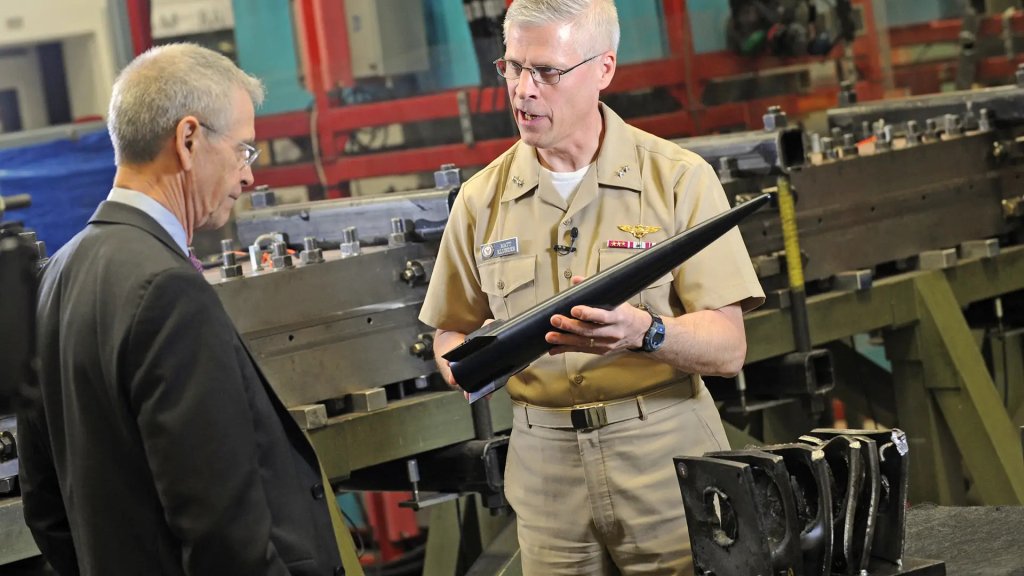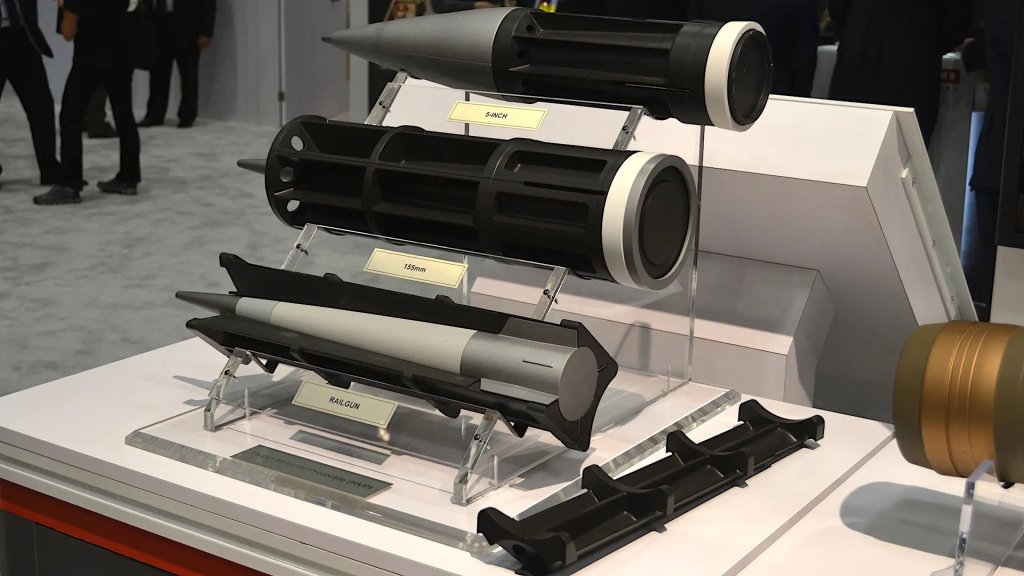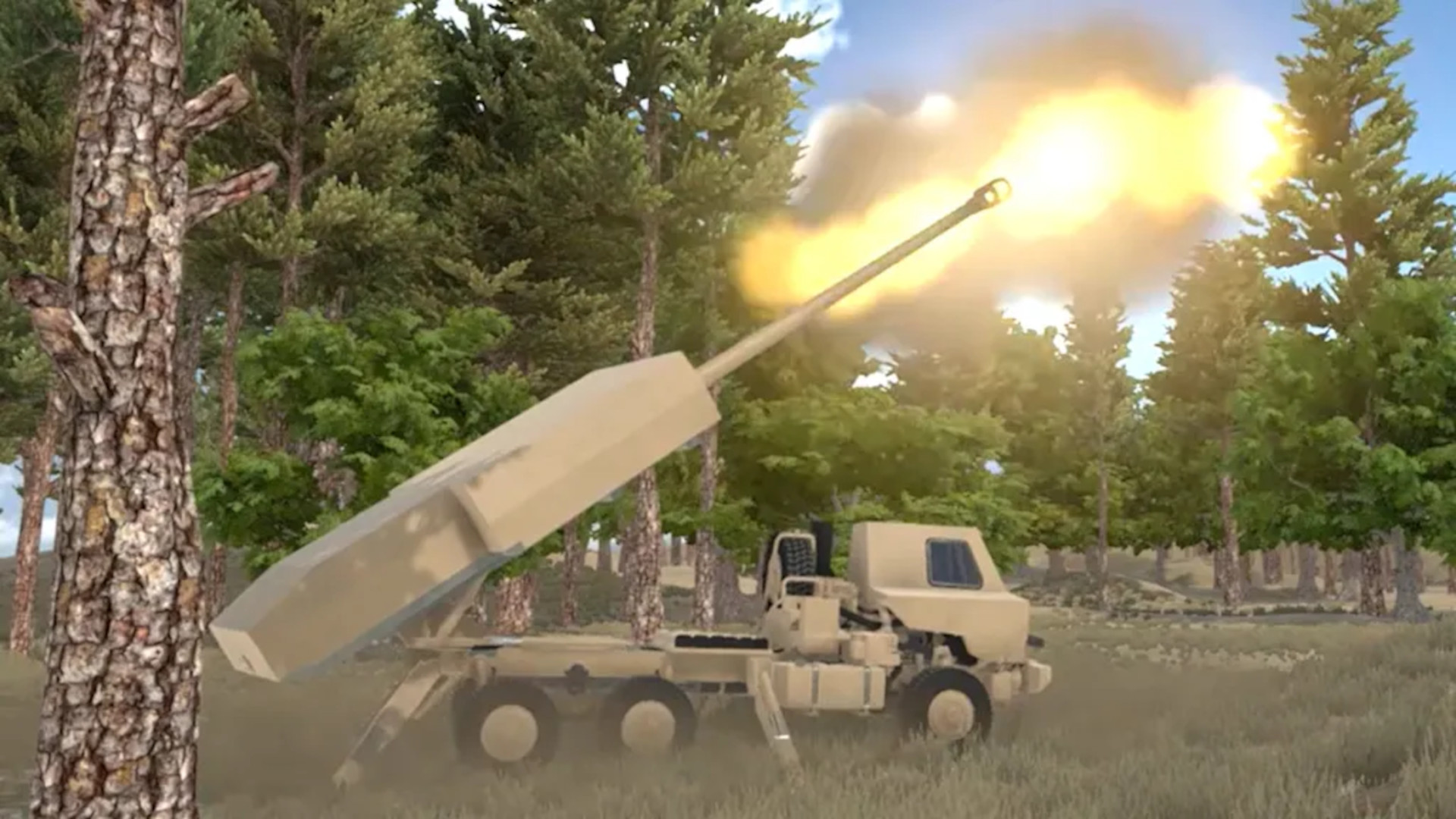The U.S. Army hopes to start fielding a new air defense system based around a wheeled self-propelled 155mm howitzer, which could use ammunition originally developed for an abortive U.S. Navy electromagnetic railgun, before the end of the decade. The service is pursuing the Multi-Domain Artillery Cannon (MDAC) as a way to further expand its already growing air and missile defense capabilities, especially in expeditionary scenarios and when it comes to defending against increasing cruise missile threats. The goal with MDAC is also to offer a lower-cost alternative to traditional surface-to-air missiles.
The Army’s Rapid Capabilities and Critical Technologies Office (RCCTO) recently issued a request for information regarding plans to acquire complete MDAC prototypes.

“Responses must clearly demonstrate technical qualifications, capability, and experience to provide a prototype MDAC solution with battery-level prototype deliveries no later than Q4FY27 [fourth quarter Fiscal Year 2027] followed by an Operational Demonstration (OD) in FY28,” the RCCTO RFI says. “The MDAC OD in FY28 will be composed of prototypes delivered under this RCCTO effort combined with similar prototypes delivered under separate Strategic Capabilities Office (SCO) Other Transaction Agreements (OTAs) developed for the Hypervelocity Gun Weapon System (HGWS).”
“Upon the conclusion of the OD the prototype will be delivered to soldiers as a residual combat capability,” the RFI adds.
The Army is looking to award the MDAC prototype contract in the third quarter of Fiscal Year 2025, according to RCCTO. Those prototypes will consist “of a wheeled self-propelled 155 mm weapon system and HVP-compatible propelling charge solution,” the RFI says.
HVP here stands for “hypervelocity projectile.” Though no specific HVP round is mentioned in the RFI, the U.S. military has displayed MDAC and related Hypervelocity Ground Weapon System (HGWS) concepts in the past alongside a BAE Systems design originally developed to be fired from a now-canceled Navy railgun. Defending against various aerial threats, including cruise and ballistic missiles, was among the roles envisioned for that weapon.


Versions of the dart-shaped precision-guided BAE HVP round have been test-fired from Navy five-inch naval deck guns and 155mm howitzers in the past. The HVP developed for use in the railgun was also a kinetic projectile designed to destroy targets through the sheer force impact after reaching a reported peak speed of 5,600 miles per hour, but the other types were expected to have high-explosive warheads. The Navy previously said that the HVP would have a maximum range of around 17 or 40 nautical miles when fired from a towed 155mm M777 howitzer or five-inch Mk 45 gun respectively.


For the new MDAC prototypes, the Army also says it wants a wheeled platform with high “tactical mobility” that also offers a significant degree of “survivability through the use of rapid emplacement and displacement” tactics.
As part of the prototyping effort, contractors can either supply their own 155mm weapon or ask for one from the Army. The complete weapon system should be heavily automated and offer “remote weapon firing capability,” “high rates of fire with [the] HVP,” “deep magazine capacity,” and “rapid ammunition resupply time (manual and automated),” according to the RFI.
The weapon also needs to be mounted on the wheeled platform in such a way as to offer a “large launch window” against incoming threats “enabled through large elevation and traverse range limits.” No mention is made of what kind of range parameters the Army is eyeing for MDAC.
The computer-generated MDAC/HGWS video, seen below, that the U.S. Air Force Research Laboratory previously released shows a notional 6×6 wheeled design with the gun mounted in a large turret at the rear of the vehicle that is also transportable via a C-130 cargo plane.

When it comes to targeting, “the HVP will communicate with off-board sensors that track both the HVP and the threat and complete the interception of the target,” RCCTO’s RFI explains. “The MDAC will interface with an external… Command and Control Battle Manager (C2BM) and the Integrated Air and Missile Defense (IAMD) Battle Command System (IBCS).”
More specific details about how the HVP projectiles the MDAC system fires will be cued and/or guided are not provided. IBCS is a new Army air and missile defense-focused network architecture intended to offer a common way to link together all manner of sensors and weapon systems, as you can read more about in this past War Zone feature. The Army hopes to begin fielding IBCS operationally either by the end of this year or early next year.

The U.S. military has already demonstrated the basic ability of a 155mm howitzer to down an aerial target with a BAE Systems HVP at least once, during a larger U.S. Air Force-led test event in 2020, video from which is seen below. An Army XM1299 tracked self-propelled howitzer – another program that has since been canceled – brought down a BQM-167 target drone acting as a surrogate for a subsonic cruise missile with an HVP in that instance. Other MDAC/HGWS test events have at least been scheduled since then.

Work on MDAC (and the related HGWS) has been primarily linked in the past to the growing demand for added defenses at forward operation locations during future expeditionary and distributed operations. The U.S. military is increasingly focused on these concepts of operations to mitigate ever-growing threats to larger established bases, even ones in the continental United States. Ever more capable air, sea, and ground-launched cruise missiles, including designs claimed to be capable of reaching hypersonic speeds, have emerged as a particular area of concern.
Future MDAC batteries could be employed against other aerial threats and be used to protect larger bases, as well. Depending on how fast the final MDAC design can engage one target and then move on to the next one, the system might also be especially valuable for tackling high-volume strikes and doing so in a more economical way than with traditional surface-to-air missiles.
“Current air and missile defense munitions require onboard guidance and targeting components that drive high munition procurement costs,” the new MDAC RFI notes. “In contrast, the MDAC seeks to significantly reduce munition costs and enhance expeditionary utility.”
What the price of a single HVP for use with MDAC might be in the end is unknown, but the kinetic railgun version of BAE’s design was estimated in the past to cost $100,000 or less. This is substantially cheaper than any of the surface-to-air missiles in the Army’s inventory today, including current-generation shoulder-fired Stingers that cost around $400,000 apiece.

The U.S. military is facing a complex air, as well as maritime, threat environment in and around the Red Sea right now as Iranian-backed Houthi militants in Yemen continue their anti-ship campaign in the region that underscores the potential value of MDAC. The Houthis have been employing a mix of kamikaze drones and cruise and ballistic missiles, as well as drone boats and other weapons. The group is the first ever to have employed an anti-ship ballistic missile in anger. The U.S. military has already expended significant numbers of surface-to-air missiles and other munitions, and at great cost, in defending against these threats, as well as to strike Houthi forces ashore.
At the same time, MDAC is not expected to be a solution to any air and missile defense threats on its own, but instead offer an additional readily deployable layer of protection when used in conjunction with other capabilities.
The Army is already in the midst of a bigger push to dramatically enlarge its air and missile defense forces, especially when it comes to shielding forces abroad and at home from cruise missiles and drones. This will include increasing the number of Patriot surface-to-air missile systems, which are in extremely high demand. The service is in the process of fielding a host of new short and medium-range air and missile defense systems, such as palletized Enduring Shield launchers loaded with AIM-9X Sidewinders and 8×8 Stryker light armored vehicles armed with Stingers and 30mm automatic cannons. Additional counter-drone capabilities like the Coyote Block 2 interceptor, as well as high-power laser and microwave directed energy weapons, are in the mix.

Given that they will be based around 155mm howitzers, there is also the potential for MDAC vehicles to be employed outside of the air and missile defense role if required. The Army is currently reassessing its future self-propelled artillery requirements, which could include wheeled types.
As it stands now, the Army has laid out a firmer plan for adding MDAC to its larger mix of forthcoming air and missile defense capabilities in the coming years.
Contact the author: joe@twz.com
